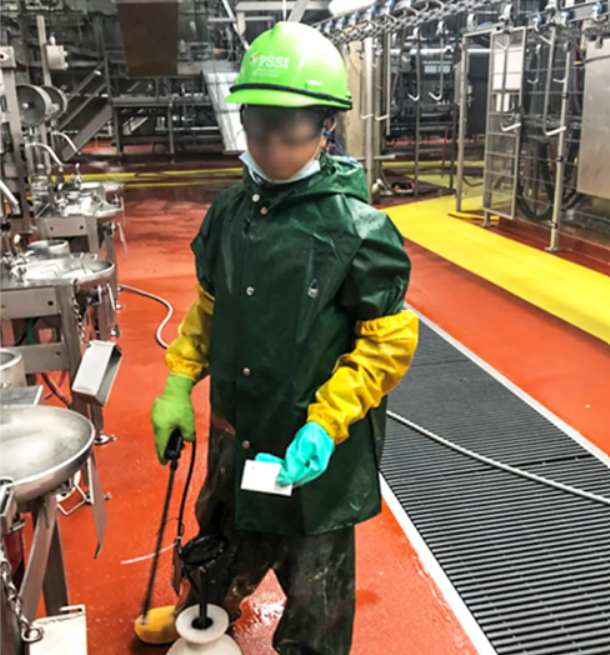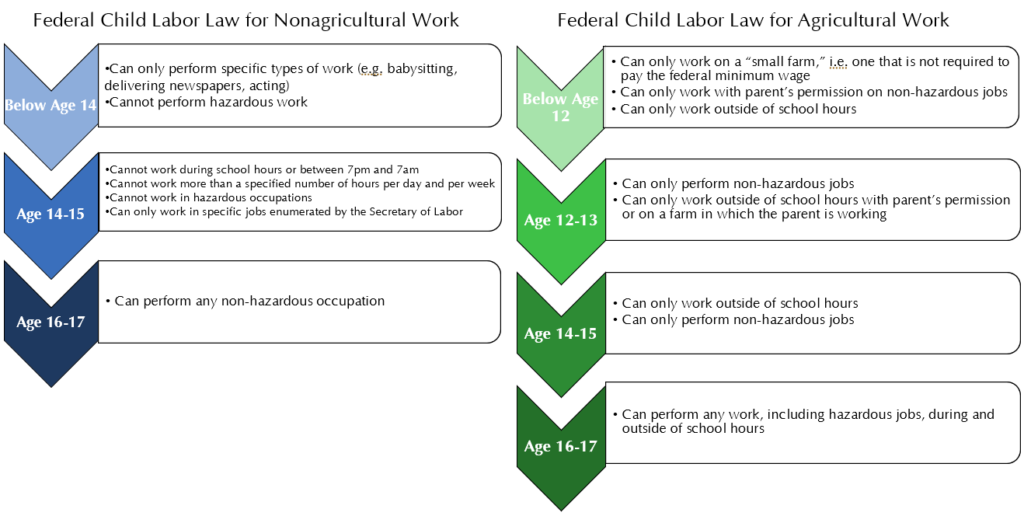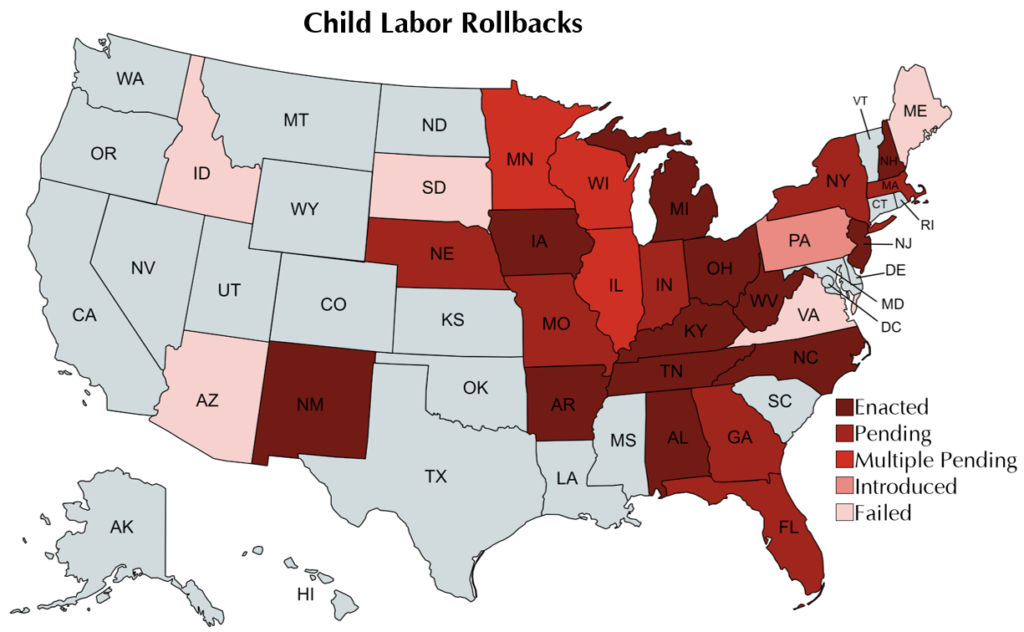The Faceless Workforce: Child Labor in the US and the Way Forward
Welcome to Advocacy Matters, a monthly column where IASJ staff members will be publishing opinion pieces about current events, human rights, environmental issues, and corporate controversies. At IASJ, we believe that, in the pursuit of social justice, advocacy matters. Advocates champion the cause of human rights and equitable economies for all. In this new monthly column, IASJ staff will share research and frontline news that informs our advocacy efforts and vision for corporate accountability. Stay tuned to IASJ’s social media and website for more articles from our staff.
February 21, 2024
The rapid rise of illegal child labor in the US tells the story of a system that is failing our children. Last year, the Department of Labor (DOL) documented a 69% increase in illegal child labor in the US since 2018. Made up of predominantly migrant children, this shadow workforce engages in dangerous work, sometimes during overnight shifts. Recent investigations have documented children as young as 13 years old engaging in hazardous work, and in some cases, children have been severely injured or killed.
The recent findings are set against the outrageous backdrop of the US being the only UN Member State, out of 197, yet to ratify the Convention on the Rights of the Child. So, how are companies and the government failing to protect children? And, what is the way forward? To answer these questions, we must first understand child labor law in the US.

* Photo released by the Department of Labor
What is Illegal Child Labor?
In the US, child labor is defined as any work that is performed by someone under 18 years of age, and although it is not per se illegal, it is subject to many restrictions. Federal law (the Fair Labor Standards Act of 1938) and state law govern which types of child labor are permitted, and which are prohibited. If the federal law is different from the law in a particular state, the law which is more protective of children applies. Child labor that falls outside the permissible activities is considered illegal child labor. Generally speaking, child labor laws govern the types of occupations children may participate in, which depend on a child’s age. In nonagricultural jobs, children can start working at age 14, with restrictions on the hours they work and the types of work they engage in; when a child is 16 or older, these restrictions are eased. Under no circumstances, can a child under 18 work in a hazardous occupation, established by the Secretary of Labor, which includes cleaning meat-processing equipment, operating balers and compactors, roofing operations, etc. The federal laws governing child labor in agricultural jobs are more lax, and despite some restrictions, even children under 12 are permitted to work in some cases. Human Rights Watch has documented the particular dangers children face when working in agriculture, even when complying with child labor law.

https://www.dol.gov/sites/dolgov/files/WHD/legacy/files/childlabor101.pdf; https://webapps.dol.gov/elaws/whd/flsa/docs/haznonag.asp; https://www.dol.gov/sites/dolgov/files/WHD/legacy/files/childlabor102.pdf; https://webapps.dol.gov/elaws/whd/flsa/docs/hazag.asp
Regarding enforcement at the federal level, the Department of Labor’s Wage and Hour Division is responsible for investigating illegal child labor and relies mostly on complaints it receives. Because children usually will not file complaints, especially migrant children who speak another language or who fear retaliation, a significant portion of cases of illegal child labor go unreported. Additionally, since the Wage and Hour Division is underfunded, many cases of illegal child labor go uninvestigated. Even when DOL investigations find illegal child labor, penalties are minimal. Currently, each violation of child labor law results in a $15,138 penalty, which may increase or decrease, depending on the gravity of the case, and $68,801 for serious injury or death of a child. Criminal penalties are available in some circumstances if the violation was willful, but are infrequent. Lastly, there is no private right of action for child labor violations, which means victims cannot sue and cannot receive remedy. Once illegal child labor is found, the employer must fire the child, but many children find their way back into employment with another company.
Why Has Illegal Child Labor Increased?
The factors leading to an increase in illegal child labor are multifaceted and cannot be explained simply, but are largely related to immigration policy, limited resources for enforcement, and legislative gaps. Experts have also highlighted the role companies have played in this increase. Companies’ exploitative labor practices have created labor shortages, and vulnerable children have stepped in to fill the openings. According to Columbia law professor Kate Andrias, “If pay were higher and conditions were better, there would likely be enough adults willing and available to do the work.”
As illegal child labor increases in the US, many states have been simultaneously trying to weaken child labor protections. In its 2023 report, the Economic Policy Institute documented 10 states that had either introduced or passed laws aimed at rolling back child labor protections. According to the report, the trend is part of a “coordinated multi-industry push to expand employer access to low-wage labor and weaken state child labor laws.” As of February 7, 2024, 28 states had introduced bills to weaken child labor laws and 12 states had enacted them.

The Way Forward
In response to the increase in illegal child labor, the governmental response has been swift, but far from comprehensive. As a first step, the DOL announced a number of steps it would take, along with the Department of Health and Human Services, to combat illegal child labor. Among these actions are holding employers accountable for child labor violations of their suppliers and calling on Congress for more funding.
In addition, several states have introduced and enacted legislation to strengthen child labor protections, and at the federal level, a number of bills have been introduced, including two bipartisan bills, that would significantly strengthen the rights of children and provide greater accountability. Experts have called for a variety of legislative and administrative reforms, including creating a private right of action for children to sue companies for damages, improving immigration processes to allow unaccompanied minors to more swiftly obtain work authorization, and significantly increasing funding for the Wage and Hour Division. Additionally, after illegal child labor is found, children should be provided with governmental assistance to take them out of a situation of vulnerability.
Together with calls on the government for broader reform, more work needs to be done on holding companies accountable that rely on illegal child labor in their value chains. Recently, IASJ filed a shareholder proposal at Tyson Foods, on behalf of the American Baptist Home Mission Society, which asked the Company to commission an independent, third-party audit assessing the effectiveness of the Company’s policies and practices in preventing illegal child labor throughout its value chain. Despite pushback from Tyson, the shareholder proposal managed to receive 54.5% independent shareholder support. IASJ continues to collaborate with our partners, like Venceremos, to uplift the rights of workers and children. The road to ending illegal child labor is long and requires systemic change, but we are hopeful that in the near future, children will no longer need to work dangerous jobs to support themselves and their families.

Aaron Acosta, Program Director


